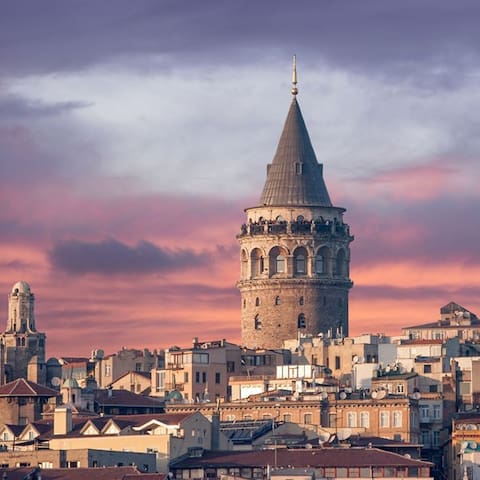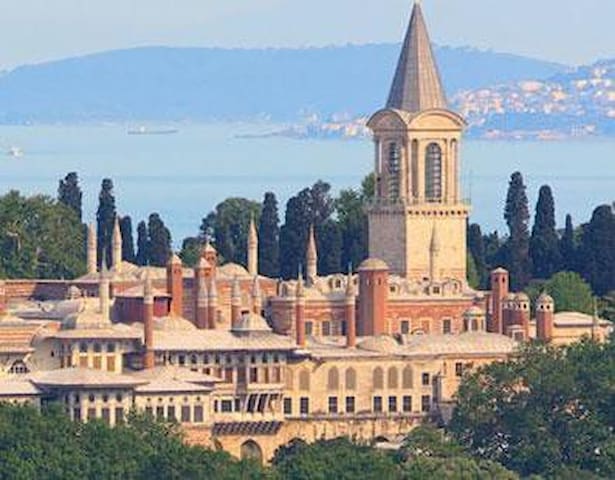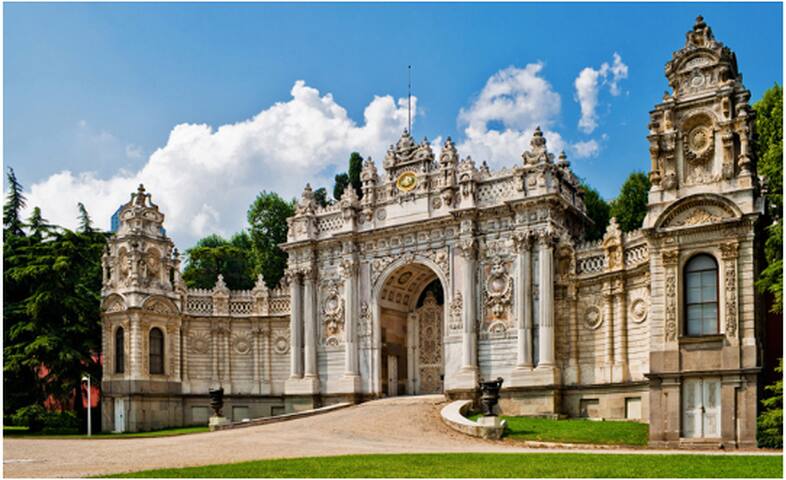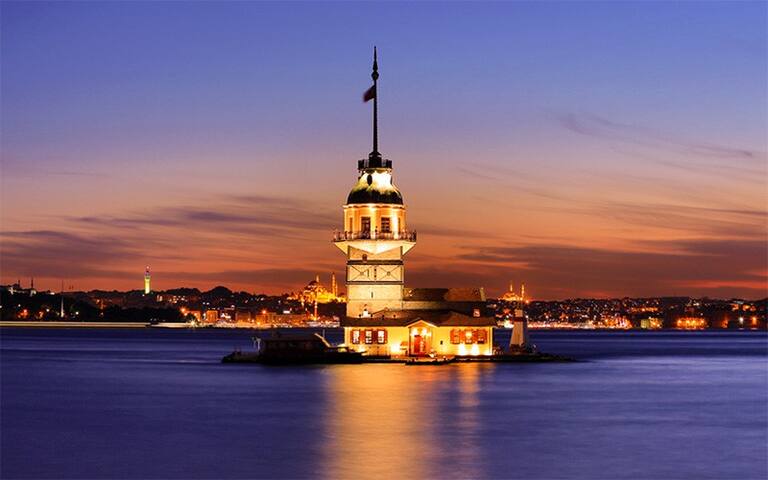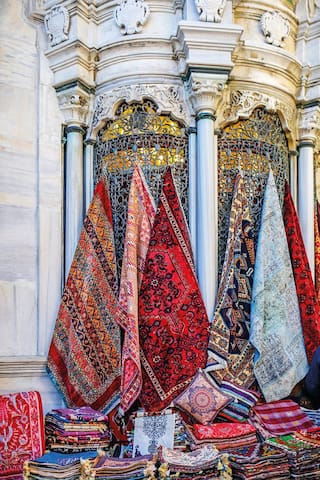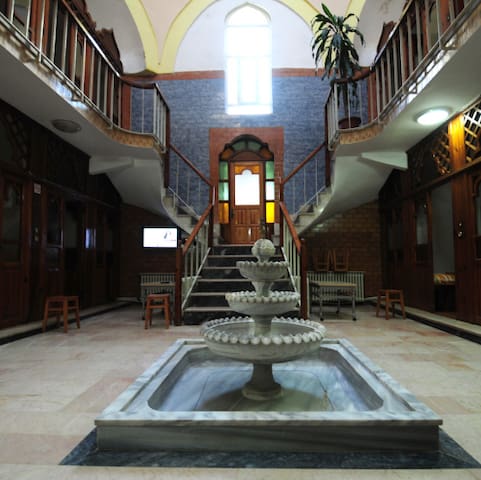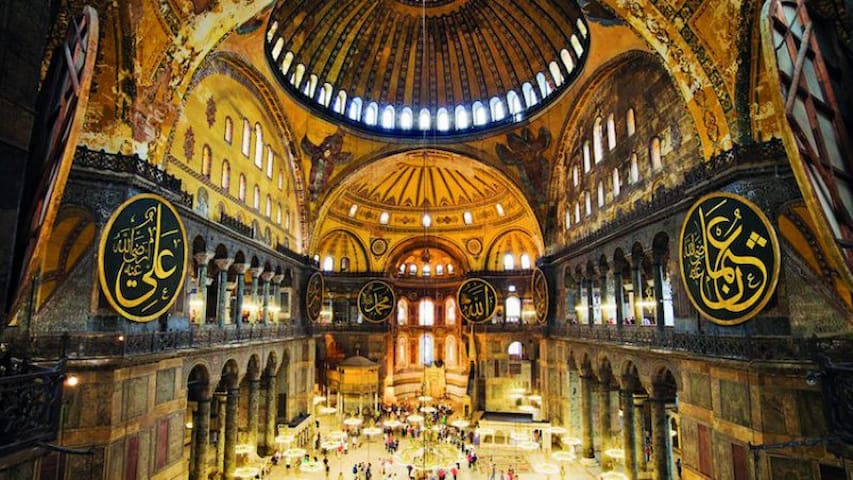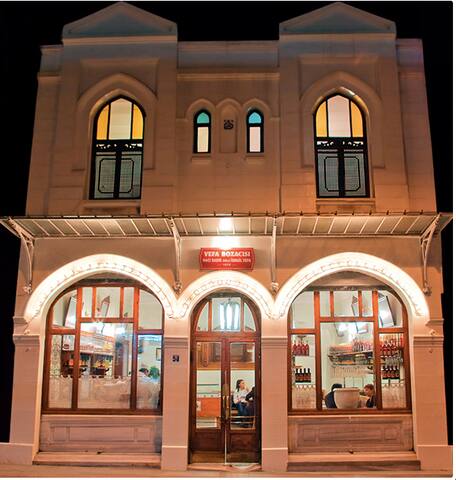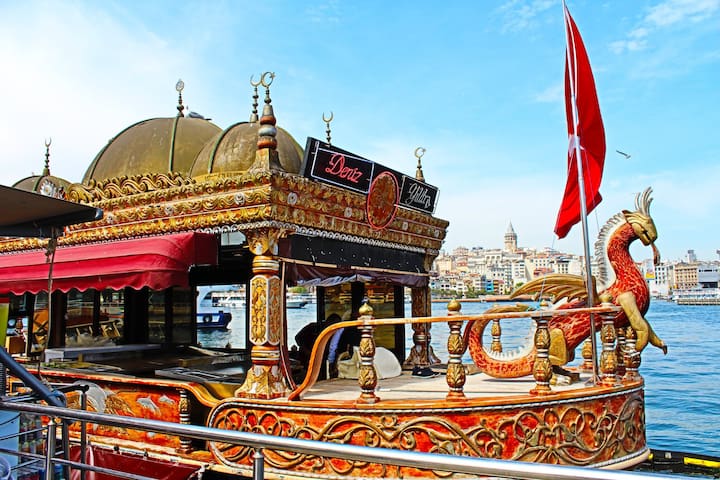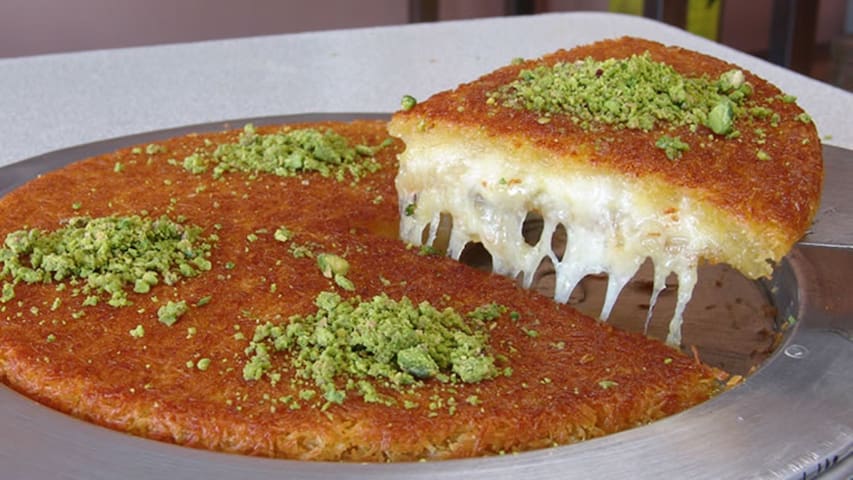Gezilecek yerler
The Galata Tower, Galata Kulesi in Turkish, is one of the highest and oldest towers of Istanbul. 63 meter (206 feet) high tower provides a panoramic view of the old town. It was built in the 14th century by the Genoese colony as part of the defense wall surrounding their district at Galata directly opposite ancient Constantinopolis. They called the tower as "Christea Turris", or "Tower of Christ". The Genoese were involved in trade with the Byzantines and the tower was used for the surveillance of the Harbor in the Golden Horn. After the conquest of Constantinople by Mehmet II, it served to detect fires in the city.
Hezarfen Ahmet Celebi was the first flying Turk during the Ottoman Empire of the 17th century. He copied bird wings and studied air flows, than jumping from the Galata Tower he overflew the Bosphorus and landed at Uskudar district on the Asian side, around 6 kilometers (4 miles) in distance.
1235 habitants recommandent
Tour de Galata
The Galata Tower, Galata Kulesi in Turkish, is one of the highest and oldest towers of Istanbul. 63 meter (206 feet) high tower provides a panoramic view of the old town. It was built in the 14th century by the Genoese colony as part of the defense wall surrounding their district at Galata directly opposite ancient Constantinopolis. They called the tower as "Christea Turris", or "Tower of Christ". The Genoese were involved in trade with the Byzantines and the tower was used for the surveillance of the Harbor in the Golden Horn. After the conquest of Constantinople by Mehmet II, it served to detect fires in the city.
Hezarfen Ahmet Celebi was the first flying Turk during the Ottoman Empire of the 17th century. He copied bird wings and studied air flows, than jumping from the Galata Tower he overflew the Bosphorus and landed at Uskudar district on the Asian side, around 6 kilometers (4 miles) in distance.
The Topkapı Palace (Turkish: Topkapı Sarayı[2] or in Ottoman Turkish: طوپقپو سرايى, Ṭopḳapu Sarāyı),[3] or the Seraglio,[4] is a large museum in Istanbul, Turkey. In the 15th century, it served as the main residence and administrative headquarters of the Ottoman sultans.
Construction began in 1459, ordered by Mehmed the Conqueror, six years after the conquest of Constantinople. Topkapı was originally called the "New Palace" (Yeni Saray or Saray-ı Cedîd-i Âmire) to distinguish it from the Old Palace [tr] in Beyazıt Square. It was given the name Topkapı, meaning Cannon Gate, in the 19th century.[5] The complex was expanded over the centuries, with major renovations after the 1509 earthquake and the 1665 fire. The palace complex consists of four main courtyards and many smaller buildings. Female members of the Sultan's family lived in the harem, and leading state officials, including the Grand vizier, held meetings in the Imperial Council building.
After the 17th century, Topkapı gradually lost its importance. The sultans of that period preferred to spend more time in their new palaces along the Bosphorus. In 1856, Sultan Abdulmejid I decided to move the court to the newly built Dolmabahçe Palace. Topkapı retained some of its functions including the imperial treasury, library and mint.
Following the end of the Ottoman Empire in 1923, Topkapı was transformed into a museum by a government decree dated April 3, 1924. The Topkapı Palace Museum is administered by the Ministry of Culture and Tourism. The palace complex has hundreds of rooms and chambers, but only the most important are accessible to the public today, including the Ottoman Imperial Harem and the treasury, called hazine where the Spoonmaker's Diamond and Topkapi Dagger are on display. The museum collection also includes Ottoman clothing, weapons, armor, miniatures, religious relics, and illuminated manuscripts like the Topkapi manuscript. The complex is guarded by officials of the ministry as well as armed guards of the Turkish military. Topkapı Palace is part the Historic Areas of Istanbul, a group of sites in Istanbul that were added to the UNESCO World Heritage Site in 1985.[
717 habitants recommandent
Palais de Topkapi
The Topkapı Palace (Turkish: Topkapı Sarayı[2] or in Ottoman Turkish: طوپقپو سرايى, Ṭopḳapu Sarāyı),[3] or the Seraglio,[4] is a large museum in Istanbul, Turkey. In the 15th century, it served as the main residence and administrative headquarters of the Ottoman sultans.
Construction began in 1459, ordered by Mehmed the Conqueror, six years after the conquest of Constantinople. Topkapı was originally called the "New Palace" (Yeni Saray or Saray-ı Cedîd-i Âmire) to distinguish it from the Old Palace [tr] in Beyazıt Square. It was given the name Topkapı, meaning Cannon Gate, in the 19th century.[5] The complex was expanded over the centuries, with major renovations after the 1509 earthquake and the 1665 fire. The palace complex consists of four main courtyards and many smaller buildings. Female members of the Sultan's family lived in the harem, and leading state officials, including the Grand vizier, held meetings in the Imperial Council building.
After the 17th century, Topkapı gradually lost its importance. The sultans of that period preferred to spend more time in their new palaces along the Bosphorus. In 1856, Sultan Abdulmejid I decided to move the court to the newly built Dolmabahçe Palace. Topkapı retained some of its functions including the imperial treasury, library and mint.
Following the end of the Ottoman Empire in 1923, Topkapı was transformed into a museum by a government decree dated April 3, 1924. The Topkapı Palace Museum is administered by the Ministry of Culture and Tourism. The palace complex has hundreds of rooms and chambers, but only the most important are accessible to the public today, including the Ottoman Imperial Harem and the treasury, called hazine where the Spoonmaker's Diamond and Topkapi Dagger are on display. The museum collection also includes Ottoman clothing, weapons, armor, miniatures, religious relics, and illuminated manuscripts like the Topkapi manuscript. The complex is guarded by officials of the ministry as well as armed guards of the Turkish military. Topkapı Palace is part the Historic Areas of Istanbul, a group of sites in Istanbul that were added to the UNESCO World Heritage Site in 1985.[
After the Peace of Zsitvatorok and the crushing loss in the 1603–18 war with Persia, Sultan Ahmet I decided to build a large mosque in Istanbul to reassert Ottoman power. It would be the first imperial mosque for more than forty years. While his predecessors had paid for their mosques with the spoils of war, Ahmet I procured funds from the Treasury, because he had not gained remarkable victories. The construction was started in 1609 and not completed until 1617.[3]
It caused the anger of the ulama, the Muslim jurists. The mosque was built on the site of the palace of the Byzantine emperors, in front of the basilica Hagia Sophia (at that time, the primary imperial mosque in Istanbul) and the hippodrome, a site of significant symbolic meaning as it dominated the city skyline from the south. Big parts of the south shore of the mosque rest on the foundations, the vaults of the old Grand Palace.[4]
803 habitants recommandent
Mosquée bleue
No:10 Atmeydanı Cd.After the Peace of Zsitvatorok and the crushing loss in the 1603–18 war with Persia, Sultan Ahmet I decided to build a large mosque in Istanbul to reassert Ottoman power. It would be the first imperial mosque for more than forty years. While his predecessors had paid for their mosques with the spoils of war, Ahmet I procured funds from the Treasury, because he had not gained remarkable victories. The construction was started in 1609 and not completed until 1617.[3]
It caused the anger of the ulama, the Muslim jurists. The mosque was built on the site of the palace of the Byzantine emperors, in front of the basilica Hagia Sophia (at that time, the primary imperial mosque in Istanbul) and the hippodrome, a site of significant symbolic meaning as it dominated the city skyline from the south. Big parts of the south shore of the mosque rest on the foundations, the vaults of the old Grand Palace.[4]
One of Istanbul's splendid historical buildings is the Basilica Cistern located in the southwest of Hagia Sophia. This large underground cistern built by Byzantine Emperor Justinian I (527-565) was named as arasında Yerebatan Palace ere among the people due to the marble columns rising from the water and countless seemingly like. It is also known as Basilica Cistern since there is a Basilica in the place where the cistern is located.
638 habitants recommandent
Citerne Basilique
1/3 Yerebatan Cd.One of Istanbul's splendid historical buildings is the Basilica Cistern located in the southwest of Hagia Sophia. This large underground cistern built by Byzantine Emperor Justinian I (527-565) was named as arasında Yerebatan Palace ere among the people due to the marble columns rising from the water and countless seemingly like. It is also known as Basilica Cistern since there is a Basilica in the place where the cistern is located.
Dolmabahce Palace built in 19 th century is one of the most glamorous palaces in the world. It was the administrative center of the late Ottoman Empire with the last of Ottoman Sultans was residing there.Â
dolmabahce palace
After the foundation of the Turkish Republic in Ankara, Mustafa Kemal Ataturk transferred all government functions to the youthful capital but on his visits to Istanbul Ataturk occupied only a small room at Dolmabahce Palace as his own. He stayed, welcomed his foreign guests and made a practical center for national, historical and language congress and for international conferences.
580 habitants recommandent
Dolmabahce Palace
Dolmabahçe CaddesiDolmabahce Palace built in 19 th century is one of the most glamorous palaces in the world. It was the administrative center of the late Ottoman Empire with the last of Ottoman Sultans was residing there.Â
dolmabahce palace
After the foundation of the Turkish Republic in Ankara, Mustafa Kemal Ataturk transferred all government functions to the youthful capital but on his visits to Istanbul Ataturk occupied only a small room at Dolmabahce Palace as his own. He stayed, welcomed his foreign guests and made a practical center for national, historical and language congress and for international conferences.
Kizkulesi is located off the coast of Salacak neighborhood in Üsküdar district, at the southern entrance of the Bosphorus. It literally means "Maiden's Tower" in Turkish. The name comes from a legend: the Byzantine emperor heard a prophecy telling him that his beloved daughter would die at the age of 18 by a snake. So he decided to put her in this tower built on a rock on the Bosphorus isolated from the land thus no snake could kill her. But she couldn't escape from her destiny after all, a snake hidden in a fruit basket brought from the city bit the princess and killed her.
Another legend wrongly mentions Hero and Leander in the tower, therefore some people wrongly call it "Leander's Tower", a sad love story told by Ovidius: Hero was one of the priestess of Aphrodite living in the tower. One day she left the tower to attend a ceremony in the temple where she met Leandros and they fall in love with each other. Leandros swam to the tower every night to visit his love, meanwhile she was holding a torch to guide him in the dark waters towards her in the tower. But on a stormy night Leandros couldn't see the light because it was put out by the winds, and he swam all night loosing his way until he was drowned. Hero, seeing that her lover died, she also jumped into the water and suicided. Some people narrate this love story as it was happened on the Bosphorus, but in fact it's a legend from the Dardanelles, when Leandros was swimming to Hero between Abydos (today's Eceabat) and Sestus (today's Canakkale city).
Kizkulesi on the BosphorusKizkulesi is dating back to the 5th century BC when it was built by the Athenian general Alcibiades on a rock at the entrance of the Bosphorus for the surveillance of the waterway. A chain was pulled from the land to the tower to make it a checkpoint and customs area for the ships going through. After several restorations in wood and stone, Emperor Alexius Comnenos built a strong defense tower in the 12th century AD calling it Arcla, meaning "Small Tower". The tower was used as a lighthouse and control tower also during the Ottoman period after the Conquest of Constantinople. Final restoration was done in 1998 and opened as a restaurant after spending around 3million US dollars.
The tower was featured in one of the James Bond movies in 1999; "The world is not enough", where the terrorists placed a nuclear submarine underneath the tower to be exploded in the heart of the city and where "M" (Judi Dench) was imprisoned by an oil tycoon's daughter (Sophie Marceu) which Bond (Pierce Brosnan) had to kill her.
325 habitants recommandent
Tour de la Vierge
Salacak MevkiiKizkulesi is located off the coast of Salacak neighborhood in Üsküdar district, at the southern entrance of the Bosphorus. It literally means "Maiden's Tower" in Turkish. The name comes from a legend: the Byzantine emperor heard a prophecy telling him that his beloved daughter would die at the age of 18 by a snake. So he decided to put her in this tower built on a rock on the Bosphorus isolated from the land thus no snake could kill her. But she couldn't escape from her destiny after all, a snake hidden in a fruit basket brought from the city bit the princess and killed her.
Another legend wrongly mentions Hero and Leander in the tower, therefore some people wrongly call it "Leander's Tower", a sad love story told by Ovidius: Hero was one of the priestess of Aphrodite living in the tower. One day she left the tower to attend a ceremony in the temple where she met Leandros and they fall in love with each other. Leandros swam to the tower every night to visit his love, meanwhile she was holding a torch to guide him in the dark waters towards her in the tower. But on a stormy night Leandros couldn't see the light because it was put out by the winds, and he swam all night loosing his way until he was drowned. Hero, seeing that her lover died, she also jumped into the water and suicided. Some people narrate this love story as it was happened on the Bosphorus, but in fact it's a legend from the Dardanelles, when Leandros was swimming to Hero between Abydos (today's Eceabat) and Sestus (today's Canakkale city).
Kizkulesi on the BosphorusKizkulesi is dating back to the 5th century BC when it was built by the Athenian general Alcibiades on a rock at the entrance of the Bosphorus for the surveillance of the waterway. A chain was pulled from the land to the tower to make it a checkpoint and customs area for the ships going through. After several restorations in wood and stone, Emperor Alexius Comnenos built a strong defense tower in the 12th century AD calling it Arcla, meaning "Small Tower". The tower was used as a lighthouse and control tower also during the Ottoman period after the Conquest of Constantinople. Final restoration was done in 1998 and opened as a restaurant after spending around 3million US dollars.
The tower was featured in one of the James Bond movies in 1999; "The world is not enough", where the terrorists placed a nuclear submarine underneath the tower to be exploded in the heart of the city and where "M" (Judi Dench) was imprisoned by an oil tycoon's daughter (Sophie Marceu) which Bond (Pierce Brosnan) had to kill her.
Taksim Square is the most known modern city center of Istanbul. Many hotels and restaurants are in or near the Square and on Istiklal Street, and there is a local bus terminal for public transportation and the main subway station. Istiklal pedestrian street has many bars, night clubs and movie theaters therefore it's always busy with young people almost for 24 hours a day. The Square is also the meeting place to celebrate New Year's Eve, parades, public concerts and other shows.
The most important monument in Taksim Square is the Independence Monument (Istiklal Aniti in Turkish), standing at the beginning of Istiklal pedestrian street. This is also the turnaround point for the old tram which is the only vehicle permitted on Istiklal Street beside official (police and government) cars.
The monument was made by the Italian sculptor Pietro Canonica and opened in 1928, it describes Atatürk, founder of the Republic, as a military commander-in-chief and a statesman. Since it's opening, the monument became the center spot of official ceremonies in Istanbul.
On its south façade overlooking the Siraselviler Street, there is Atatürk, Ismet Inönü and Fevzi Çakmak in the front and other figures behind them, including two Russian generals. On the north façade overlooking at Cumhuriyet Street, the War of Independence is symbolized. On the east and west façades, the Turkish Army is symbolized with a soldier holding the Turkish Flag.
Across this monument on the other side of the Square, there is a huge building which is Atatürk Cultural Center. In the early years of the Republic, an opera building was started to build which was completed after a long construction period of 13 years. It was opened with the name of Istanbul Cultural Palace in 1969 but suffered a great damage because of a fire in 1970. It was renovated and was given the name of Atatürk Cultural Center in 1978, known as AKM. Several national and international concerts, operas, meetings, exhibitions and premiers were held in AKM, especially performances of Istanbul State Theaters, State Opera and Ballet, State Symphony Orchestra, State Turkish Classic Music Chorus, and International Istanbul Festival attracted many spectators. Nowadays it's being rennovated again thus closed since 2008.
During the late Ottoman period Sultan Mahmut I arranged Taksim as a point where the main water lines from north of Istanbul were collected and branched off to other districts of the city. Therefore the Square took its name from the big stone reservoir located on the west side of the square; "taksim" means "distribution" in Turkish.
During some of the daily city tours in Istanbul you may have a chance to pass thru this lively Square.
Click here for high resolution photo gallery of Taksim.
Beyoglu and Istiklal Street
Beyoglu next to the Taksim Square is an important part of modern Istanbul, it's a great way to get away from the old city and enjoy modern Istanbul as the local people do. There is so much going on in the approximately 2,5 kilometers (1,5 mile) long street between Taksim Square and the Tünel funicular stop near Galata Tower where you can spend a whole day here. You can find a different kind of Istanbul in every corner, there is a hidden story of the city everywhere. Religions, languages and ethnic groups live brotherly around here, it's the center of art and culture, many national, international and local activities reach art lovers through the neighborhood.
Old tram on Istiklal street in BeyogluBeyoglu is mostly a residential area consisting of 45 neighborhoods and about 245,000 residents, but the daily population goes up to a million in this center of commerce, entertainment and culture. It's one of the most important tourist points and one of the most famous avenues of the city, distinguished brands of business and entertainment world serves in this area as well. Many exquisite boutiques, music and bookstores, libraries, art galleries, cinemas, theaters, cafes, bars, restaurants, pubs, coffee houses, patisseries, chocolateries, and technological centers are lined on Istiklal Street.
Beyoglu has a large number of foreigners of all nationalities living in this neighborhood. The area is also home to significant Turkish Christian and Jewish communities, there are several churches and synagogues.
The Galatasaray Square is almost at the halfway of the Avenue and houses one of the oldest educational institutions established in Turkey during the Ottoman Empire; formerly known as Mekteb-i Sultani (School of Sultans), todays Galatasaray Lisesi (high school) where the Galatasaray football team was founded in 1905.
Across Galatasaray Square there are some historic buildings such as the Cicek Pasaji (The Flower Courtyard) with many small restaurants and taverns, and Balik Pazari (Fish Market) where you can find some fresh fish and vegetables.
On the same street and on its side streets there are several churches such as St. Antony and Santa Maria, Armenian Churches, Synagogues, old mosques, Pera Palace Hotel built in 1892 by George Nagelmackers, academic and cultural institutions established by various European nations such as Germany, Italy, Austria, and France in the early 19th century, consulates of several nations including Germany, France, Greece, Sweden, Armenia, Russia, Netherlands, Spain, Sweden, and United Kingdom, amongst which the British and German consulates being the most impressive buildings in the area.
To the end of this pedestrian street towards Galata, there is Tunnel, the world's second-oldest subway, connecting Pera district with Karaköy district on the Golden Horn. Just before Tunnel you can visit Divan Literature Museum which is called as Galata Mevlevihane belonging to Mevlevi order founded by Mevlana, where Whirling Dervish ceremonies are performed twice a month.
Old Galata and Pera neighborhoods were inhabited since the Byzantine Empire. During the 19th century Ottoman Empire, the street was known as Grande Rue de Pera and the district became a center for foreigners, Levantines, Ottoman intellectuals and western culture admirers. After 1923 the street's name was changed to Istiklal (Independence in Turkish) to commemorate the War of Independence led by Atatürk.
932 habitants recommandent
Taksim Square
Taksim Square is the most known modern city center of Istanbul. Many hotels and restaurants are in or near the Square and on Istiklal Street, and there is a local bus terminal for public transportation and the main subway station. Istiklal pedestrian street has many bars, night clubs and movie theaters therefore it's always busy with young people almost for 24 hours a day. The Square is also the meeting place to celebrate New Year's Eve, parades, public concerts and other shows.
The most important monument in Taksim Square is the Independence Monument (Istiklal Aniti in Turkish), standing at the beginning of Istiklal pedestrian street. This is also the turnaround point for the old tram which is the only vehicle permitted on Istiklal Street beside official (police and government) cars.
The monument was made by the Italian sculptor Pietro Canonica and opened in 1928, it describes Atatürk, founder of the Republic, as a military commander-in-chief and a statesman. Since it's opening, the monument became the center spot of official ceremonies in Istanbul.
On its south façade overlooking the Siraselviler Street, there is Atatürk, Ismet Inönü and Fevzi Çakmak in the front and other figures behind them, including two Russian generals. On the north façade overlooking at Cumhuriyet Street, the War of Independence is symbolized. On the east and west façades, the Turkish Army is symbolized with a soldier holding the Turkish Flag.
Across this monument on the other side of the Square, there is a huge building which is Atatürk Cultural Center. In the early years of the Republic, an opera building was started to build which was completed after a long construction period of 13 years. It was opened with the name of Istanbul Cultural Palace in 1969 but suffered a great damage because of a fire in 1970. It was renovated and was given the name of Atatürk Cultural Center in 1978, known as AKM. Several national and international concerts, operas, meetings, exhibitions and premiers were held in AKM, especially performances of Istanbul State Theaters, State Opera and Ballet, State Symphony Orchestra, State Turkish Classic Music Chorus, and International Istanbul Festival attracted many spectators. Nowadays it's being rennovated again thus closed since 2008.
During the late Ottoman period Sultan Mahmut I arranged Taksim as a point where the main water lines from north of Istanbul were collected and branched off to other districts of the city. Therefore the Square took its name from the big stone reservoir located on the west side of the square; "taksim" means "distribution" in Turkish.
During some of the daily city tours in Istanbul you may have a chance to pass thru this lively Square.
Click here for high resolution photo gallery of Taksim.
Beyoglu and Istiklal Street
Beyoglu next to the Taksim Square is an important part of modern Istanbul, it's a great way to get away from the old city and enjoy modern Istanbul as the local people do. There is so much going on in the approximately 2,5 kilometers (1,5 mile) long street between Taksim Square and the Tünel funicular stop near Galata Tower where you can spend a whole day here. You can find a different kind of Istanbul in every corner, there is a hidden story of the city everywhere. Religions, languages and ethnic groups live brotherly around here, it's the center of art and culture, many national, international and local activities reach art lovers through the neighborhood.
Old tram on Istiklal street in BeyogluBeyoglu is mostly a residential area consisting of 45 neighborhoods and about 245,000 residents, but the daily population goes up to a million in this center of commerce, entertainment and culture. It's one of the most important tourist points and one of the most famous avenues of the city, distinguished brands of business and entertainment world serves in this area as well. Many exquisite boutiques, music and bookstores, libraries, art galleries, cinemas, theaters, cafes, bars, restaurants, pubs, coffee houses, patisseries, chocolateries, and technological centers are lined on Istiklal Street.
Beyoglu has a large number of foreigners of all nationalities living in this neighborhood. The area is also home to significant Turkish Christian and Jewish communities, there are several churches and synagogues.
The Galatasaray Square is almost at the halfway of the Avenue and houses one of the oldest educational institutions established in Turkey during the Ottoman Empire; formerly known as Mekteb-i Sultani (School of Sultans), todays Galatasaray Lisesi (high school) where the Galatasaray football team was founded in 1905.
Across Galatasaray Square there are some historic buildings such as the Cicek Pasaji (The Flower Courtyard) with many small restaurants and taverns, and Balik Pazari (Fish Market) where you can find some fresh fish and vegetables.
On the same street and on its side streets there are several churches such as St. Antony and Santa Maria, Armenian Churches, Synagogues, old mosques, Pera Palace Hotel built in 1892 by George Nagelmackers, academic and cultural institutions established by various European nations such as Germany, Italy, Austria, and France in the early 19th century, consulates of several nations including Germany, France, Greece, Sweden, Armenia, Russia, Netherlands, Spain, Sweden, and United Kingdom, amongst which the British and German consulates being the most impressive buildings in the area.
To the end of this pedestrian street towards Galata, there is Tunnel, the world's second-oldest subway, connecting Pera district with Karaköy district on the Golden Horn. Just before Tunnel you can visit Divan Literature Museum which is called as Galata Mevlevihane belonging to Mevlevi order founded by Mevlana, where Whirling Dervish ceremonies are performed twice a month.
Old Galata and Pera neighborhoods were inhabited since the Byzantine Empire. During the 19th century Ottoman Empire, the street was known as Grande Rue de Pera and the district became a center for foreigners, Levantines, Ottoman intellectuals and western culture admirers. After 1923 the street's name was changed to Istiklal (Independence in Turkish) to commemorate the War of Independence led by Atatürk.
Istanbul’s Grand Bazaar is high on most tourists’ itineraries, and for a good reason. This enormous site is the largest covered market in the world. Since its size and the variety of goods available make it easy to lose one’s bearings, follow our advice on how not to lose it while getting lost in the narrow streets.
810 habitants recommandent
Grand Bazar
Beyazıt CaddesiIstanbul’s Grand Bazaar is high on most tourists’ itineraries, and for a good reason. This enormous site is the largest covered market in the world. Since its size and the variety of goods available make it easy to lose one’s bearings, follow our advice on how not to lose it while getting lost in the narrow streets.
Çinili Bathhouse was ordered to be built in 1640 by Kösem Sultan. She had died by the time bathhouse’s women’s only part was finished and the construction was continued to be funded by her brother in her legacy. The bathhouse was originally planned to be used by the workers who are working in the construction of the Çinili mosque. The construction plan for the mosque had included a library and a police station as well as the bathhouse. But do not be mistaken by the word “Çinili” (this word, “Çini”, is used for a special type of blue porcelain used in the decoration of royal buildings and “Çinili” means “with blue porcelain”) because those fantastic works of art were stolen by thieves. Nevertheless the bathhouse’s managers had restored the authenticity of the bathhouse by decorating it with blue stones. The restoration process had only been done to the door ornaments and walls and thus the general architectural outline of the bathhouse had not been changed. Even the outer domes are preserved from the ruinous effects of time without seeing any restoration effort. Although it is hard to believe the reliefs on the marble basins also had not been touched or restored by any means and thus you can enjoy your bath in an uniquely authentic Ottoman bathhouse. The great August earthquake had not even scratched the walls of the bathhouse which are 2 meters thick.
The historical aspects and beauty of the Çinili bathhouse had been heard and used by numerous directors and photographers and thus many movies and magazines had covered the bathhouse.
Çinili bathhouse has a antique heating system. A huge boiler is placed between two domes, near to the bathhouse’s women’s only part. This boiler is heated by great logs and approximately one ton of log are used to heat the bathhouse in the winter season. The heat is directed through pipes which are routed under and through the walls the bathhouse. The excess smoke is thrown from chimneys called as “Tüfeklik” (which is also a special Turkish word which can be roughly translated as Riflehole). There are many aspects which sets Çinili bathhouse apart from the others. In addition to its authentic historical setting, the managers are very careful about general cleanliness and hygiene of the bathhouse as well as offering quality service, therefore you can enjoy your bath in the Çinili bathhouse surrounded by the fragrance of the 367 years of history.
Generally the bathhouses are called dark and overcast, but Çinili bathhouse does not have these aspects. Because the bathhouse is spaciously built and the holes in the domes of the bathhouse does not block the sunlight. When the bathhouse is too hot, the bell shaped glass coverings can be removed to cool the interior.
7 habitants recommandent
Bains turcs de Çinili
Çinili Bathhouse was ordered to be built in 1640 by Kösem Sultan. She had died by the time bathhouse’s women’s only part was finished and the construction was continued to be funded by her brother in her legacy. The bathhouse was originally planned to be used by the workers who are working in the construction of the Çinili mosque. The construction plan for the mosque had included a library and a police station as well as the bathhouse. But do not be mistaken by the word “Çinili” (this word, “Çini”, is used for a special type of blue porcelain used in the decoration of royal buildings and “Çinili” means “with blue porcelain”) because those fantastic works of art were stolen by thieves. Nevertheless the bathhouse’s managers had restored the authenticity of the bathhouse by decorating it with blue stones. The restoration process had only been done to the door ornaments and walls and thus the general architectural outline of the bathhouse had not been changed. Even the outer domes are preserved from the ruinous effects of time without seeing any restoration effort. Although it is hard to believe the reliefs on the marble basins also had not been touched or restored by any means and thus you can enjoy your bath in an uniquely authentic Ottoman bathhouse. The great August earthquake had not even scratched the walls of the bathhouse which are 2 meters thick.
The historical aspects and beauty of the Çinili bathhouse had been heard and used by numerous directors and photographers and thus many movies and magazines had covered the bathhouse.
Çinili bathhouse has a antique heating system. A huge boiler is placed between two domes, near to the bathhouse’s women’s only part. This boiler is heated by great logs and approximately one ton of log are used to heat the bathhouse in the winter season. The heat is directed through pipes which are routed under and through the walls the bathhouse. The excess smoke is thrown from chimneys called as “Tüfeklik” (which is also a special Turkish word which can be roughly translated as Riflehole). There are many aspects which sets Çinili bathhouse apart from the others. In addition to its authentic historical setting, the managers are very careful about general cleanliness and hygiene of the bathhouse as well as offering quality service, therefore you can enjoy your bath in the Çinili bathhouse surrounded by the fragrance of the 367 years of history.
Generally the bathhouses are called dark and overcast, but Çinili bathhouse does not have these aspects. Because the bathhouse is spaciously built and the holes in the domes of the bathhouse does not block the sunlight. When the bathhouse is too hot, the bell shaped glass coverings can be removed to cool the interior.
Hagia Sophia means "Holy Wisdom". The great Hagia Sophia was built on the remains of another church in 537, converted into a mosque in 1453 and it is a museum since 1931. With its massive dome, it was the largest church in the world for nearly a thousand years, till 1520.
90 habitants recommandent
Hagia Sophia
No:1 Ayasofya MeydanıHagia Sophia means "Holy Wisdom". The great Hagia Sophia was built on the remains of another church in 537, converted into a mosque in 1453 and it is a museum since 1931. With its massive dome, it was the largest church in the world for nearly a thousand years, till 1520.
Yemek ortamı
Hadji Sadık Bey (our grandfather) came from Prizren, Albania to Istanbul in 1870. During those years, he saw that around 200 shopkeepers of the townspeople produced and sold boza as a dark-coloured, sour-tasted, juicy-thick beverage. He experimented with a different technique in that period; and today’s thick, straw-coloured slightly-sour flavour, which is given at the moment when fermentation bubbles are newly formed, became the first signature of the brand. He promoted the boza, which he produced through his own means in the cellar of his house, by circulating it in copper billycans that he carried on his shoulders around the Palace and its surroundings at winter nights for six years. Being impatiently waited for at each corner, Hadji Sadık Bey took heart with the increasing demand. He opened the first official business of boza product in September 1876 in Vefa, one of the most distinguished neighbourhoods in Istanbul where dynasties, aristocrat families and bureaucrats of the era resided. The boza shop that was opened in Vefa was named “Vefa Bozacısı” (Vefa Boza Shop), and this ancestral beverage was both standardised and made into a profession, maintaining its continuity for generations. Hadji Sadık Bey produced this special, sought-after Turkish beverage himself for many years in order to maintain its thickness and flavour. Taking along his son, Ismail Hakkı Vefa into business in the later years, Hadji Sadık Bey continued production in Vefa Bozacısı together with his son. Started by Hadji Sadık Bey and maintained by family members of the 4th generation today, boza production is continued according to Turkish standards by preserving the traditional palatal delight.
32 habitants recommandent
Vefa Bozacisi
66 Vefa Cd.Hadji Sadık Bey (our grandfather) came from Prizren, Albania to Istanbul in 1870. During those years, he saw that around 200 shopkeepers of the townspeople produced and sold boza as a dark-coloured, sour-tasted, juicy-thick beverage. He experimented with a different technique in that period; and today’s thick, straw-coloured slightly-sour flavour, which is given at the moment when fermentation bubbles are newly formed, became the first signature of the brand. He promoted the boza, which he produced through his own means in the cellar of his house, by circulating it in copper billycans that he carried on his shoulders around the Palace and its surroundings at winter nights for six years. Being impatiently waited for at each corner, Hadji Sadık Bey took heart with the increasing demand. He opened the first official business of boza product in September 1876 in Vefa, one of the most distinguished neighbourhoods in Istanbul where dynasties, aristocrat families and bureaucrats of the era resided. The boza shop that was opened in Vefa was named “Vefa Bozacısı” (Vefa Boza Shop), and this ancestral beverage was both standardised and made into a profession, maintaining its continuity for generations. Hadji Sadık Bey produced this special, sought-after Turkish beverage himself for many years in order to maintain its thickness and flavour. Taking along his son, Ismail Hakkı Vefa into business in the later years, Hadji Sadık Bey continued production in Vefa Bozacısı together with his son. Started by Hadji Sadık Bey and maintained by family members of the 4th generation today, boza production is continued according to Turkish standards by preserving the traditional palatal delight.
Eminönü Pier seems sheer chaos, but it is the exemplified chaos of life that works perfectly right. Mostly the Pier resembles an anthill. People are coming from all directions, and from the underground. They arrive on foot or leave, go on a boat trip or return from one, or get in or out of the tram. Eminönü Pier is not a static, quiet place, but a dynamic, loud one. Here you cannot escape the crowds and the sensual impressions connected with them. Here sounds and smells determine the atmosphere: maybe the horn of a vapur, maybe the smell of fried fish. When you are hungry, you can have a balık ekmek at one of the floating fish restaurants. They are typical here and the fish sandwich tastes delicious.
From Eminönü Pier you can take a boat that takes you to the next station of your stay in Istanbul.
Eminönü Balıkçıları
Eminönü Pier seems sheer chaos, but it is the exemplified chaos of life that works perfectly right. Mostly the Pier resembles an anthill. People are coming from all directions, and from the underground. They arrive on foot or leave, go on a boat trip or return from one, or get in or out of the tram. Eminönü Pier is not a static, quiet place, but a dynamic, loud one. Here you cannot escape the crowds and the sensual impressions connected with them. Here sounds and smells determine the atmosphere: maybe the horn of a vapur, maybe the smell of fried fish. When you are hungry, you can have a balık ekmek at one of the floating fish restaurants. They are typical here and the fish sandwich tastes delicious.
From Eminönü Pier you can take a boat that takes you to the next station of your stay in Istanbul.
You can see so many waiters on the street and all of them will invite you for delicious and cheap breakfast.. And it is true.. you can find so many different cafe's to make breakfast or take e coffe.. I love this place and every week at least one time I am coming to eat something delicious.. If you are hungry and trying to find something cheap and delicious, you have to come this little street.. "Cafe Faruk" is the first cafe that opened here and I think you have to eat "Full Menemen" and "Bişi" here.. It is kind of difficult to find some free table at weekend si I suggest you to come early if you want to come at weekend.. And if it is a sunny day, here has to be the first destination, you won't regret.:)
Çelebi Oğlu Sokak
Çelebi Oğlu SokakYou can see so many waiters on the street and all of them will invite you for delicious and cheap breakfast.. And it is true.. you can find so many different cafe's to make breakfast or take e coffe.. I love this place and every week at least one time I am coming to eat something delicious.. If you are hungry and trying to find something cheap and delicious, you have to come this little street.. "Cafe Faruk" is the first cafe that opened here and I think you have to eat "Full Menemen" and "Bişi" here.. It is kind of difficult to find some free table at weekend si I suggest you to come early if you want to come at weekend.. And if it is a sunny day, here has to be the first destination, you won't regret.:)
Beşiktaş Çıtır Pide Lahmacun Salonu
No:34 Altıntaş Sk.Turkish Pizza
Ekol Künefe
50 B Nuhkuyusu Cd
